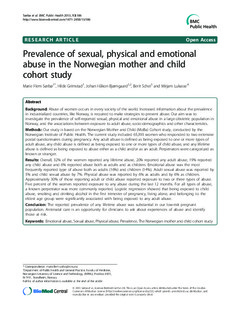| dc.contributor.author | Sørbø, Marie Flem | |
| dc.contributor.author | Grimstad, Hilde | |
| dc.contributor.author | Bjørngaard, Johan Håkon | |
| dc.contributor.author | Schei, Berit | |
| dc.contributor.author | Lukasse, Mirjam | |
| dc.date.accessioned | 2016-04-28T11:45:22Z | |
| dc.date.accessioned | 2016-05-03T13:10:30Z | |
| dc.date.available | 2016-04-28T11:45:22Z | |
| dc.date.available | 2016-05-03T13:10:30Z | |
| dc.date.issued | 2013 | |
| dc.identifier.citation | BMC Public Health 2013, 13 | nb_NO |
| dc.identifier.issn | 1471-2458 | |
| dc.identifier.uri | http://hdl.handle.net/11250/2388433 | |
| dc.description.abstract | Background
Abuse of women occurs in every society of the world. Increased information about the prevalence in industrialized countries, like Norway, is required to make strategies to prevent abuse. Our aim was to investigate the prevalence of self-reported sexual, physical and emotional abuse in a large obstetric population in Norway, and the associations between exposure to adult abuse, socio-demographics and other characteristics.
Methods
Our study is based on the Norwegian Mother and Child (MoBa) Cohort study, conducted by the Norwegian Institute of Public Health. The current study included 65,393 women who responded to two extensive postal questionnaires during pregnancy. Any adult abuse is defined as being exposed to one or more types of adult abuse, any child abuse is defined as being exposed to one or more types of child abuse, and any lifetime abuse is defined as being exposed to abuse either as a child and/or as an adult. Perpetrators were categorized as known or stranger.
Results
Overall, 32% of the women reported any lifetime abuse, 20% reported any adult abuse, 19% reported any child abuse and 6% reported abuse both as adults and as children. Emotional abuse was the most frequently reported type of abuse both as adults (16%) and children (14%). Adult sexual abuse was reported by 5% and child sexual abuse by 7%. Physical abuse was reported by 6% as adults and by 6% as children. Approximately 30% of those reporting adult or child abuse reported exposure to two or three types of abuse. Five percent of the women reported exposure to any abuse during the last 12 months. For all types of abuse, a known perpetrator was more commonly reported. Logistic regression showed that being exposed to child abuse, smoking and drinking alcohol in the first trimester of pregnancy, living alone, and belonging to the eldest age group were significantly associated with being exposed to any adult abuse.
Conclusion
The reported prevalence of any lifetime abuse was substantial in our low-risk pregnant population. Antenatal care is an opportunity for clinicians to ask about experiences of abuse and identify those at risk. | nb_NO |
| dc.language.iso | eng | nb_NO |
| dc.publisher | BioMed Central | nb_NO |
| dc.rights | Navngivelse 4.0 Internasjonal | |
| dc.rights.uri | http://creativecommons.org/licenses/by/4.0/deed.no | |
| dc.subject | Emotional abuse – Sexual abuse – Physical abuse – Prevalence – The Norwegian mother and child cohort study | nb_NO |
| dc.title | Prevalence of sexual, physical and emotional abuse in the Norwegian mother and child cohort study | nb_NO |
| dc.type | Journal article | nb_NO |
| dc.type | Peer reviewed | nb_NO |
| dc.date.updated | 2016-04-28T11:45:22Z | |
| dc.description.version | publishedVersion | |
| dc.source.volume | 13 | nb_NO |
| dc.source.journal | BMC Public Health | nb_NO |
| dc.source.issue | 186 | nb_NO |
| dc.identifier.doi | 10.1186/1471-2458-13-186 | |
| dc.identifier.cristin | 1020379 | |
| dc.description.localcode | This article is published under license to BioMed Central Ltd. This is an Open Access article distributed under the terms of the Creative Commons Attribution License (http://creativecommons.org/licenses/by/2.0), which permits unrestricted use, distribution, and reproduction in any medium, provided the original work is properly cited. | nb_NO |

